|
|
Main »
Kobudo
|
|
|
|
Kobudo
|
|
In the Medieval the inhabitants of Okinawa lacking the possibility to
possess any sort of weapon, started using tools and equipment destined
for everyday use (mainly agricultural in their skirmishes with the
Samurais.
Thus, within a few hundred years the kabudo style - (fighting
with weapons) arose and become an integral part of traditional karate.
Its effectiveness was called upon by its creators when, unarmed, they
had to fight Samurai, which on average could make four movements with
their swords in a single second.
Five main instruments are used in Kobudo. They are:
-
the
Bo
- pole,
-
the
Sai
- blunt trident,
-
the
Nunchaku
- small flail,
-
the
Tonfa
- a mill-wheel handle,
-
the
Kama-scythe
.
All these types of arms are an integral part of Okinawa Te, an entire classic Martial art in itself. The following weapons used to be employed;
-
Eku
- oars,
-
Tekko
- a type of brass-knuckles,
-
Suratin
- two small rocks joined by either a leather band or a metal chain,
-
Tinbe
- a turtle shell shield
.
However they presently do not to conform to modern Kobudo.
|
Tonfa (トンファー)
|
Nunchaku (ヌンチャク)
|
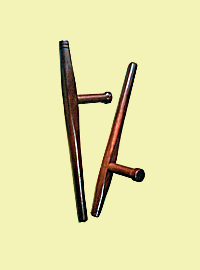
|
A mill-wheel handle . It is made of very hard types
of wood such as oak or cherry. Its average length is anywhere from 40
to 50 centimeters. The handle is fixed as a rule at a 90 degree angle,
15 cm from one of the ends. Two tonfas are usually used at the same
time, one in each hand. It reinforces the karate master's upper arm,
thus facilitating the possibility to repel attacks. The tonfa can
inflict a great number of unexpected blows. It is presently used in a
lot of countries as a police baton.
|

|
Little flails used for threshing rice called nuchaka
- (the translation of the Japanese character "noon" is "identical" or
"double" and that of "chaka" - is segment), the most famous type of
kobudo in the world, it is banned as an weapon in a lot of countries
due to its deadly powers. Devised of two wooden cylinders 30 to 40
centimeters in length it is joined in the middle by a rope made of
either silk or horse hair. Nunchakus are very effective for defense as
well as for attack.
|
Kama-scythe (鎌 or かま)
|
Sai (釵)
|
 ;
;
|
There
are three varieties: mid-length and long, which are used for harvesting
the Papaya fruit and the short ,which is used in the collection of
rice. In Kobudo all three types are used but it is the short kama, the
most widely used, that has become a classical Kobudo weapon. Usually
used in pairs, it has a Parrot-beak shaped blade which can be sharpened
using the file located in the middle of the wooden handle.
|

|
The
blunt trident used for hoeing when planting rice, called sai, was
developed as an arm in defense against swords. Made of steel, it weighs
from 800 to 1200 grams and is 35 to 50 centimeters in length. It is
widely used for both making blocks and attacks. It is generally used in
pairs.
|
Bo (棒: ぼう)
|
Tinbe (ティンベ)
|

|
The
word "Roku" is Japanese means six, "shaku", stands for measurement
approximately equal in length to one foot, and "bo" - is a wooden yoke
used for carrying buckets. Fishermen then transformed them into a means
for transporting boats through mangrove thickets. It is used in open
fields. It makes it possible to defend oneself or to attack within a
360 degree circle.
|
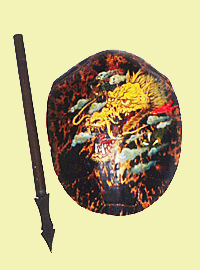
|
Fabricated from the shells of giant turtles living
in the coastal waters around Okinawa. Originally used as a basket for
carry vegetables or in the field as a sun-screen. In Kobudo it was
transformed into a shield.
|
Eku (エーク)
|
Suratin (スルチン)
|
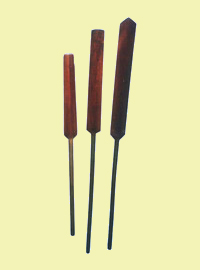
|
Oars used for rowing or as a rudder. Its use is
similar to the Bo, but the technique for using Eku differs from the Bo
because the Eku has a different center of gravity.
|
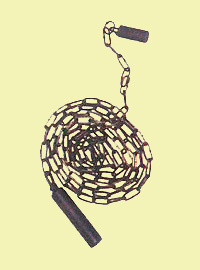
|
Two stones joined by either a metal wire or a
leather cord. The former with a metal wire were used for mooring small
boats in the port of Naha, and the latter were used to strengthen the
moorings. They are used either as an offensive weapon or for making
blocks. They are very effective in fights with adversaries armed with
different types of steel weapons, such as the sword. With the aid of
Surutin you can dislodge your adversary's sword or tangle it up in the
metal wire. The metal wire or leather strip come in different lengths
and they have an average weight of 400 grams.
|
Tekko (鉄甲)
|
Bo (棒: ぼう) vs Sai (釵)
|
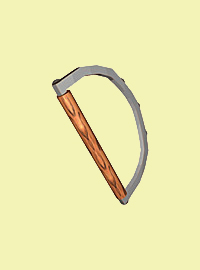
|
Used for easing the handling of horses harnessed to
carriages. In Kobudo they are employed for inflicting blows or for
blocking the impact of other weapons.
|
 ;
;
|
Kihon kumite kobudo
|
|
|
|
|
-->
-->
|



 ;
;






 ;
;